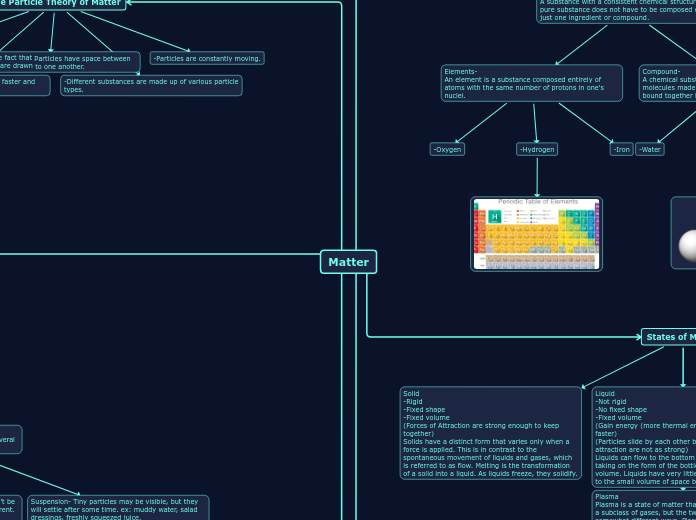Matter
Pure substances
A substance with a consistent chemical structure. A pure substance does not have to be composed of just one ingredient or compound.
Elements-
An element is a substance composed entirely of atoms with the same number of protons in one's nuclei.
-Oxygen
-Hydrogen
-Iron
Compound-
A chemical substance is made up of several similar molecules made up of atoms from different elements bound together by chemical bonds.
-Water
-Table salt
-Ammonia
States of Matter
Solid
-Rigid
-Fixed shape
-Fixed volume
(Forces of Attraction are strong enough to keep together)
Solids have a distinct form that varies only when a force is applied. This is in contrast to the spontaneous movement of liquids and gases, which is referred to as flow. Melting is the transformation of a solid into a liquid. As liquids freeze, they solidify.
Liquid
-Not rigid
-No fixed shape
-Fixed volume
(Gain energy (more thermal energy) and move faster)
(Particles slide by each other because forces of attraction are not as strong)
Liquids can flow to the bottom of a bottle and fill it, taking on the form of the bottle but not altering the volume. Liquids have very little compressibility due to the small volume of space between objects.
Gas
-Not rigid
-No fixed shape
-No fixed volume
Gas is a state of matter that does not have a fixed form or thickness. Other states of matter, such as solids and liquids, have a smaller density than gases.
Plasma
Plasma is a state of matter that is often mistaken for a subclass of gases, but the two behave in somewhat different ways. Plasmas, on the other hand, are made up of atoms that have had any or more of their electrons taken out, allowing positively charged nuclei, known as ions, to roam freely.
Ex-
-Lightning
-Solar wind
-Aurora
-Nuclear fireball
-Fluorescent light
Separation Techniques-
-by eye
-by filtration
-distillation (heat to separate substances with different boiling points)
-chromatography
The Particle Theory of Matter
-Particles make up all matter.
-Despite the fact that particles have space between them, they are drawn to one another.
-Particles are constantly moving.
-When particles are heated, they move faster and further apart.
-Different substances are made up of various particle types.
Mixtures
A mixture is a medium composed of two or more distinct compounds that have not been chemically mixed.
Homogeneous mixtures (Solutions)-
Is a mixture with which the structure is consistent throughout. Since the dissolved substance is found in the same volume in the solution, all solutions are called homogeneous.
-Saltwater
-mouth wash
Heterogeneous mixtures-
is a mixture in which the composition varies from one part to the next. Two or more phases make up a heterogeneous mixture. When oil and water are mixed together, they form two distinct layers rather than mixing equally.
-Pizza
-Solid waste dump
Mechanical Mixture-You can tell the difference between different types of matter. There are several phases (types do not mix).
Ordinary Mechanical Mixture- The many particles are large enough to see and remain mixed.
ex: sand, Milk and cereal
Colloid- The particles are so small that they can't be seen, and they're almost a solution but transparent. ex: foam, aerosols, gels, milk
Suspension- Tiny particles may be visible, but they will settle after some time. ex: muddy water, salad dressings, freshly squeezed juice.
Alloys
As a compound or a solution, an alloy is a metallic material made up of two or more elements. The constituents of alloys are usually metals, while carbon, a nonmetal, is a necessary component of steel. Alloys incorporate the properties of metals to improve their suitability for their intended use.
-brass
-pewter
-phosphor bronze
-amalgam
-steel
